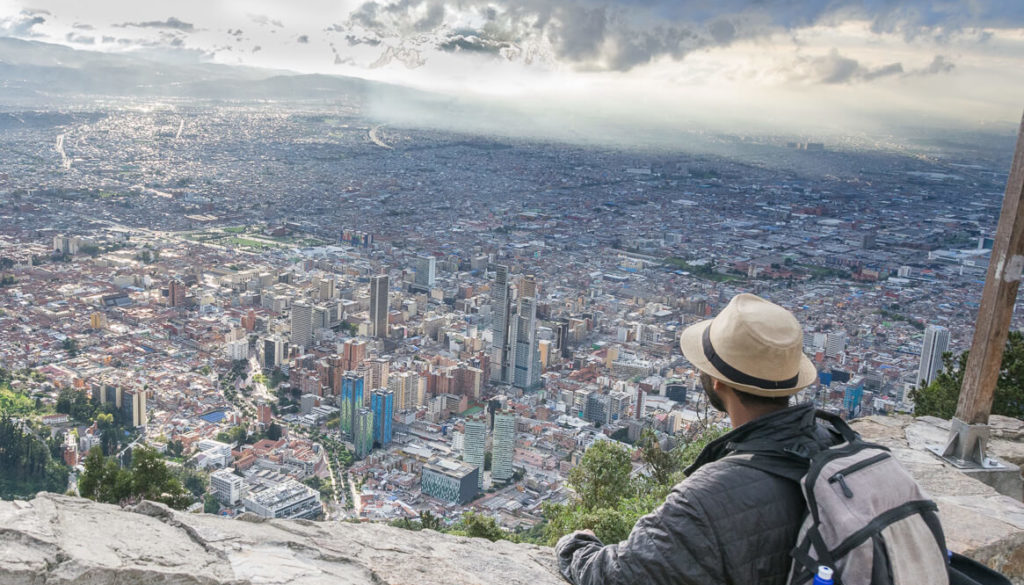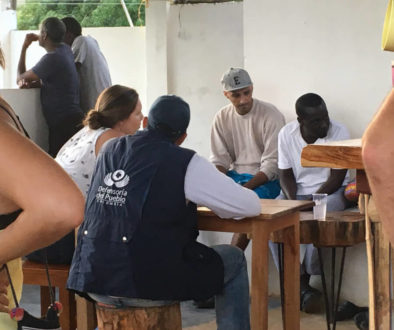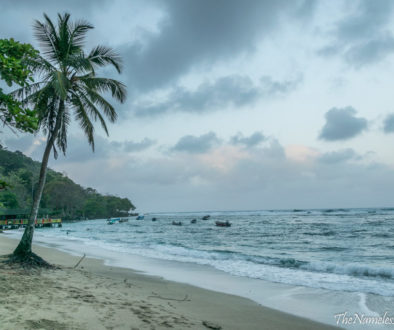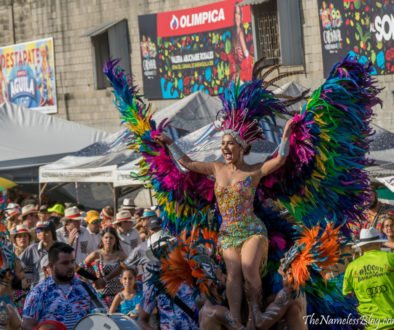Bogota Colombia Weekend Guide, Then & Now
Arriving to Bogota after having read a few blogs and talked to a few travelers I had low expectations. I had even thought about skipping out on the city all together. The general conclusion from the traveler’s point of view isn’t exactly flattering. Most people sum Bogota up as just another city with a few cool eateries, bars and some interesting graffiti. Not to mention the weather is largely cloudy, rainy and cold especially coming from its warmer neighbors.
Bogota Colombia Then & Now
Bogota and Colombia in general have a rough past. Their history is plagued with drug cartels, paramilitaries groups, guerrillas and corrupt politicians. The people have all but given up on a political savior. Nonetheless Bogota has made huge strides in the safety of the country. It’s an interesting time to travel Colombia. They are currently making history with their peace talks with the guerrilla armies. FARC, the largest of the guerilla group was granted a deal with the country to surrender their weapons to the United Nations, reintegrate into society with the aid of government programs and register as a recognized political party.
This deal is very controversial throughout the country. Many citizens support the surrender and many oppose. From conversations with many locals it seems that people from the cities support the deal while the people from the countryside do not. Talking with a universality engineer professor named Carlos it’s his opinion that the people of the cities support the surrender because it is a means to an end. Furthermore he explains that the people from the cities were not exposed to the violence of the guerillas to the degree that people of the countryside were exposed. Most of the kidnappings, torture, stolen land and murders were centralized to the countryside where the guerillas could grow their armies, produce their drugs and carry out day to day activities.
Today there are continued peace talks with ELN, the second largest of the guerilla groups in Colombia.
No matter if you support or oppose the deal one thing is clear, Colombia is changing. No longer is it home to the most dangerous city on Earth or plagued with violence. Sure, in a city like Bogota you’ll still find the same petty crime you’d expect to find in any other large city but it’s no more dangerous than the next city of its kind.
Do you recognize this building? It’s the rebuilt Palace of Justice. The Netflix series Narcos would have you believed Pablo Escobar had it destroyed. According to the city tour this has never been confirmed. Another theory is that the paramilitary group did it as a protest (they started out as students & priests). The fire was started from the inside leaving some Colombians to believe the corrupt politicians used this as a means to destroy evidence against them held at this location.
Best of Bogota
The best part of Bogota for me was the clash of old vs new and I don’t mean physical appearances. The past history and the current happenings of Bogota is what makes it interesting.
- City Walking Tour – Free (tip based), 10am & 2pm. Starting everyday in front of Museo de Oro. This tour is a good introduction to the history of Colombia’s capital city and highly recommended.
- Graffiti Walking Tour – Free (tip based)10 am & 2p. Starting everyday in Parque de Los Periodistas. This is highly recommended to further your knowledge of Colombia’s history through the eyes of street artists.

The “Pineapple Grenade” symbols in the background represent a plea to plant foods instead of bombs. Artist DJ Lu

“Warbugs”. Bugs with guns for arms symbolize how the bugs and war are a similar nuisance. Artist DJ Lu
- La Candelaria – take a walk around the old town. It’s colorful, charming and full of life during the day. Take note that this area is largely commercial leaving it emptier during the evenings and nights. Take precautions if in the area after dark. Tourists have been known to fall victims of bag snatchers and pickpockets.


- Cerro Monserrate – Take the cable car up to the top of the mountain. Try to time your visit for the most amazing sunset on a clear night.


- Museo Botero – Free. Fernando Botero, Colombia’s most famous artist. Known for his work with disproportionate figures and objects. He donated many pieces of art worth millions of dollars to fund art programs for inspiring Colombian artists.
- Mercado Usaquen – One of the most popular street and food markets. Held every Sunday.
- Ciclovia – Held every Sunday from 0700 – 1400 many of the main avenues in Bogota are closed for the public to enjoy via foot and bicycle. It’s a good chance to come out and mingle with the other people flooding the streets.
- National Museum – $4,000 COP (~$1.33USD) This was my favorite museum in Bogota. It has a bit of everything including similar objects to what you’d find it Museo de Oro.
- Museo de Oro – $4,000 COP (~$1.33USD), Free on Sundays. The gold museum is a favorite in Bogota and the most popular of its kind. Take note that the objects are much smaller than you would imagine from the advertisements that are enlarged.
- Museo de la Esmeralda – Free with wristband gifted from city walking tour. Colombia is the world’s largest producer of quality emeralds. Also enjoy the city view from the 23rd floor where museum is located.
Nightlife
- Parque de la 93 – This is a park in the north of the city surrounded by bars and restaurants. It’s a trendy and safe area. Expect things to cost more here than the rest of Bogota. Examples $15,000 COP ($5USD) beers, $30,000 COP ($10USD) mixed drinks, 20-30,000 COP ($7-$10USD) for meals.
- Habana 93 – a recommended option just along the park. They have live music and a very nice atmosphere on the weekends.
- La Candelaria – the old town has a ton of bars and restaurants. The difficult part here is that this area is largely considered unsafe in terms of petty crime against tourists in the evenings.
Where to Stay
- Chapinero – this would be my best recommendation for a good stay in Bogota. Problem is there aren’t any hostels here, just a few hotels and a decent amount of Airbnb (where I stayed).
- La Candelaria – most of the hostels are located in the old town which leaves you with some evening safety issues.
How to Get Around
- Uber – very popular in Bogota and of better value than yellow taxis.
Where to Eat
- Food Tour – Free (tip based). M-F 1400 in front of Museo de Oro. You only pay for the food you want to try. All nine samples from various shops around the city will total 22,200 COP (~$7USD).
- Arte y Pasion Cafe – for the serious coffee lover. Not only can you order which kind of drink you’d like you can also specify from which type of machine you want it to be brewed in. 8 total contraptions.

- Henrry – this is a small local shop and home of The Godzilla Empanada. The biggest of its kind. $8,000 COP (~$2.75USD). Enough to feed 2 people as if it were a full meal. You’ll feel like dying after you eat it but it makes for a great photo. You can find the shop along Parque de Los Periodistas and CL 18.
Staple Dishes & Drinks
- Ajiaco – a beloved local soup and a must try if in the area. Normally served with chicken but can be vegetarian friendly upon request. Sold all over the city.
- Aguardiente – the classic Colombian spirit. I can’t really say you’ll enjoy it but when in Colombia do as a Colombian. TIP: having it chilled is far less hazardous tasting than room temperature.
- Chicha – this is a fermented drink usually derived from corn and grain leading to alcohol. It’s important in the history of the indigenous people. In what is now believed to have been a plot sponsored by the modern beer companies the government ran a smear campaign against the indigenous drink. Advertising to the Colombian people false beliefs about the drink. Which lead the population to abandon the home-made drink and replace it with store bought beer. Therefore funneling profits to the beers companies.
Arrival & Departure
Daily buses leave out to all corners of the country including Cali, Medellin (10 hours 50-68,000 COP; $16-$23USD), Cartagena and Santa Marta.
Afterthoughts
I’m not sure if it was my initially low expectations or if Bogota really blew me away but I really enjoyed the city. After a few weeks in Colombia it was the first place that I really felt like I learned where the country is coming from and where the country is aimed towards going. There is so much more to Colombia than Pablo Escobar, corrupt police and bad politicians. It’s a country with a dark past but a bright future.



